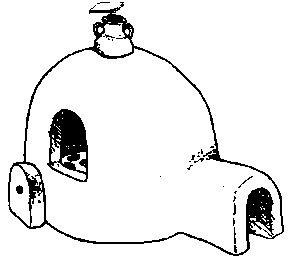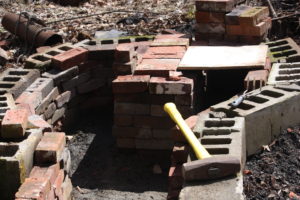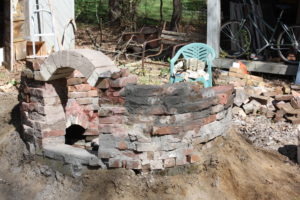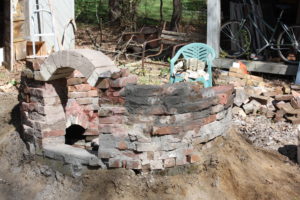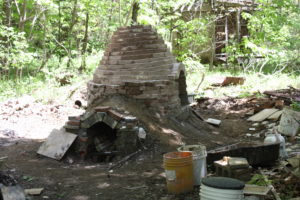GREEK STYLE UPDRAFT KILN PROJECT
Description: Small updraft kilns are a marked improvement over pit firings, allowing for the concentration of heat and the gradual cooling off of the ware, thus reducing cracked pots. An early form of updraft kiln is the bank side tunnel kiln, typically seen in Asian ceramics of the period and later. In this sort of kiln the fire is set at the bottom of the tunnel and the ware is located somewhere uphill near the exit. Natural draft takes the heat up the tunnel and fires the ware to low-fire, non-glaze temps. If the fire is maintained over many days then ash glaze may be produced. This is a very inefficient way to fire clay as most of the heat is sent up the tunnel and out the stack without coming into contact with the ware. The Greek style kiln is an improvement.
First of all the kiln is typically dug into the earth in order to produce an upward draft with the fire and ware boxes insulated by the earth berm. There is at least one example of the Greek kiln using a very long, Asian-like style fire box located down a hill from the ware chamber. Typically, however, the fire box is located to the side of the ware chamber with the flue channeling the heat under the ware floor and up through the ware and out the flue located at the top of the dome covering the ware chamber. Most people would say the kiln resembles an igloo.
In my project I was constrained by my back injuries making it difficult and painful to dig out the fire box, so I used cinder blocks to form the same shape, lined the inside with brick and bermed up the sides to insulate the structure. The center peninsula was formed by a row of cinder blocks covered in a layer of brick. This center structure is what holds the ware floor pieces. In a period kiln the floor is made of fired clay wedge-shaped pieces set with holes to allow the flow of heat. In my project I felt to save time and not change the firing process I could use old modern kiln shelves as my floor. This allows the same flow of air through the chamber and thus the same firing schedule without having to go through the process of making floor pieces and perfecting that technology. I will in time attempt to make these pieces and substitute them for the modern floor, but in the meantime I want the kiln to be usable as quickly as possible.
The fire chamber which is under the ware chamber has an opening to which the fire box is attached. The fire box has an arched roof and is about a meter long and half a meter tall. It can be sealed with a spare kiln shelf and/or bricks. The ware door is arched and is 14” wide and 20” tall. It will be sealed with bricks, some of which are shaped for the arch.
This image shows the double wall construction of the ware chamber with the fire box bermed off to the right. The arched opening for the ware chamber is shown completed. Part of the floor is in place. The kiln walls are built up to the level of the door arch and then slowly corbeled until at the top the opening can be covered completely with two half shelves.
Shows the outside of the kiln plastered with clay to plug cracks and bermed to provide insulation. The fire box opening can be seen inside the kiln chamber door. Bricks are moistened with a slip of clay and placed in the wall. Any large cracks are plugged with wads of clay and smoothed over.
The completed kiln. The opening on the dome is covered with two half-shelves which can be arranged to control the draft like a damper. The final application of clay will smooth the outside of the kiln, allowing rain to easily roll off the surface. The ware door on the opposite side is bricked up and plugged with clay after loading the kiln. Fire starts in the opening of the fire box and advances into the kiln, eventually creating a bed of hot coals beneath the kiln floor. The more fuel burning the less oxygen is in the ware chamber, creating a “reduction firing” which is required for the red/black ware renown by the Greeks. As the iron rich clay burns the oxygen is reduced from the iron oxide, producing a dark black iron color. If the ware is exposed to the air before cooling sufficiently the iron will re-combine with the air and the black will fade to a rust red. Thus careful fueling and cooling is essential to produce the Greek ware.
